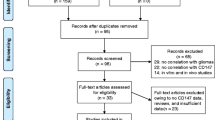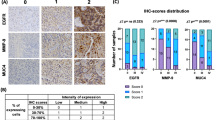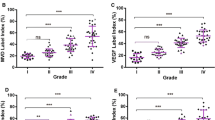Abstract
Recently, research efforts in identifying prognostic molecular biomarkers for malignant glioma have intensified. Cysteine-rich protein 61 (CCN1) is one of the CCN family of matricellular proteins that promotes cell growth and angiogenesis in cancers through its interaction with several integrins. In this study, we investigated the relationships among CCN1, O6-methylguanine-DNA methyltransferase expression, the tumor removal rate, and prognosis in 46 glioblastoma patients treated at the Okayama University Hospital. CCN1 expression was high in 31 (67 %) of these patients. The median progression-free survival (PFS) and overall survival (OS) times of patients with high CCN1 expression was significantly shorter than those of patients with low CCN1 expression (p < 0.005). In a multivariate Cox analysis, CCN1 proved to be an independent prognostic factor for patient survival [PFS, hazard ratio (HR) = 3.53 (1.55–8.01), p = 0.003 and OS, HR = 3.05 (1.35–6.87), p = 0.007]. Moreover, in the 31 patients who underwent gross total resection, the PFS and OS times of those with high CCN1 expression were significantly shorter than those with low CCN1 expression. It was concluded that CCN1 might emerge as a significant prognostic factor regarding the prognosis of glioblastoma patients.




Similar content being viewed by others
References
Stupp R, Mason WP, van den Bent MJ et al (2005) Radiotherapy plus concomitant and adjuvant temozolomide for glioblastoma. N Engl J Med 352:987–996
Lafuente JV, Alkiza K, Garibi JM et al (2000) Biologic parameters that correlate with the prognosis of human gliomas. Neuropathology 20:176–183
Wick W, Weller M, Weiler M, Batchelor T, Yung AW, Platten M (2011) Pathway inhibition: emerging molecular targets for treating glioblastoma. Neuro Oncol 13:566–579
von Deimling A, Korshunov A, Hartmann C (2011) The next generation of glioma biomarkers: MGMT methylation, BRAF fusions and IDH1 mutations. Brain Pathol 21:74–87
Pegg AE (1990) Mammalian O6-alkylguanine-DNA alkyltransferase: regulation and importance in response to alkylating carcinogenic and therapeutic agents. Cancer Res 50:6119–6129
Esteller M, Hamilton SR, Burger PC, Baylin SB, Herman JG (1999) Inactivation of the DNA repair gene O6-methylguanine-DNA methyltransferase by promoter hypermethylation is a common event in primary human neoplasia. Cancer Res 59:793–797
Brell M, Tortosa A, Verger E et al (2005) Prognostic significance of O6-methylguanine-DNA methyltransferase determined by promoter hypermethylation and immunohistochemical expression in anaplastic gliomas. Clin Cancer Res 11:5167–5174
Babic AM, Kireeva ML, Kolesnikova TV, Lau LF (1998) CYR61, a product of a growth factor-inducible immediate early gene, promotes angiogenesis and tumor growth. Proc Natl Acad Sci 95:6355–6360
O’Brien TP, Yang GP, Sanders L, Lau LF (1990) Expression of cyr61, a growth factor-inducible immediate-early gene. Mol Cell Biol 10:3569–3577
Walsh CT, Radeff-Huang J, Matteo R et al (2008) Thrombin receptor and RhoA mediate cell proliferation through integrins and cysteine-rich protein 61. FASEB J 22:4011–4021
Holbourn KP, Acharya KR, Perbal B (2008) The CCN family of proteins: structure-function relationships. Trends Biochem Sci 33:461–473
Burke E, Grobler M, Elderfield K et al (2013) Double-labelling immunohistochemistry for MGMT and a “cocktail” of non-tumourous elements is a reliable, quick and easy technique for inferring methylation status in glioblastomas and other primary brain tumours. Acta neuropathologica commun 1:22
Zhou ZQ, Cao WH, Xie JJ et al (2009) Expression and prognostic significance of THBS1, Cyr61 and CTGF in esophageal squamous cell carcinoma. BMC Cancer 9:291
Watari H, Xiong Y, Hassan MK, Sakuragi N (2009) Cyr61, a member of ccn (connective tissue growth factor/cysteine-rich 61/nephroblastoma overexpressed) family, predicts survival of patients with endometrial cancer of endometrioid subtype. Gynecol Oncol 112:229–234
Tang QL, Chen WL, Tan XY et al (2011) Expression and significance of Cyr61 in distant metastasis cells of human primary salivary adenoid cystic carcinoma. Oral Surg Oral Med Oral Pathol Oral Radiol Endod 112:228–236
Sabile AA, Arlt MJ, Muff R et al (2012) Cyr61 expression in osteosarcoma indicates poor prognosis and promotes intratibial growth and lung metastasis in mice. J Bone Miner Res 27:58–67
Chintalapudi MR, Markiewicz M, Kose N et al (2008) Cyr61/CCN1 and CTGF/CCN2 mediate the proangiogenic activity of VHL-mutant renal carcinoma cells. Carcinogenesis 29:696–703
Esteller M, Toyota M, Sanchez-Cespedes M et al (2000) Inactivation of the DNA repair gene O6-methylguanine-DNA methyltransferase by promoter hypermethylation is associated with G to A mutations in K-ras in colorectal tumorigenesis. Cancer Res 60:2368–2371
Lalezari S, Chou AP, Tran A et al (2013) Combined analysis of O6-methylguanine-DNA methyltransferase protein expression and promoter methylation provides optimized prognostication of glioblastoma outcome. Neuro Oncol 15:370–381
Xie D, Yin D, Wang HJ et al (2004) Levels of expression of CYR61 and CTGF are prognostic for tumor progression and survival of individuals with gliomas. Clin Cancer Res 10:2072–2081
Xie D, Miller CW, O’Kelly J et al (2001) Breast cancer. Cyr61 is overexpressed, estrogen-inducible, and associated with more advanced disease. J Biol Chem 276:14187–14194
Xie JJ, Xu LY, Wu ZY et al (2011) Expression of cysteine-rich 61 is correlated with poor prognosis in patients with esophageal squamous cell carcinoma. Eur J Surg Oncol 37:669–674
Xie D, Yin D, Tong X et al (2004) Cyr61 is overexpressed in gliomas and involved in integrin-linked kinase-mediated Akt and beta-catenin-TCF/Lef signaling pathways. Cancer Res 64:1987–1996
Chien W, Kumagai T, Miller CW et al (2004) Cyr61 suppresses growth of human endometrial cancer cells. J Biol Chem 279:53087–53096
Chen PP, Li WJ, Wang Y et al (2007) Expression of Cyr61, CTGF, and WISP-1 correlates with clinical features of lung cancer. PLOS One 2:e534
Maeta N, Osaki M, Shomori K et al (2007) CYR61 downregulation correlates with tumor progression by promoting MMP-7 expression in human gastric carcinoma. Oncology 73:118–126
Haseley A, Boone S, Wojton J et al (2012) Extracellular matrix protein CCN1 limits oncolytic efficacy in glioma. Cancer Res 72:1353–1362
Miyazaki M, Nishihara H, Terasaka S et al (2014) Immunohistochemical evaluation of O6 -methylguanine DNA methyltransferase (MGMT) expression in 117 cases of glioblastoma. Neuropathology 34:268–276
De Salvo M, Maresca G, D’Agnano I et al (2011) Temozolomide induced c-Myc-mediated apoptosis via Akt signalling in MGMT expressing glioblastoma cells. Int J Radiat Biol 87:518–533
Parisi MS, Gazzerro E, Rydziel S, Canalis E (2006) Expression and regulation of CCN genes in murine osteoblasts. Bone 38:671–677
Balss J, Meyer J, Mueller W, Korshunov A, Hartmann C, von Deimling A (2008) Analysis of the IDH1 codon 132 mutation in brain tumors. Acta Neuropathol 116:597–602
Massague J (2008) A very private TGF-beta receptor embrace. Mol Cell 29:149–150
Chahal M, Xu Y, Lesniak D et al (2010) MGMT modulates glioblastoma angiogenesis and response to the tyrosine kinase inhibitor sunitinib. Neuro Oncol 12:822–833
Sanai N, Polley MY, McDermott MW, Parsa AT, Berger MS (2011) An extent of resection threshold for newly diagnosed glioblastomas. J Neurosurg 115:3–8
Bendas G, Borsig L (2012) Cancer cell adhesion and metastasis: selectins, integrins, and the inhibitory potential of heparins. Int J Cell Biol 2012:676731
Pistollato F, Abbadi S, Rampazzo E et al (2010) Intratumoral hypoxic gradient drives stem cells distribution and MGMT expression in glioblastoma. Stem Cells 28:851–862
Haque I, Mehta S, Majumder M et al (2011) Cyr61/CCN1 signaling is critical for epithelial-mesenchymal transition and stemness and promotes pancreatic carcinogenesis. Mol Cancer 10:8
Kurozumi K, Hardcastle J, Thakur R et al (2008) Oncolytic HSV-1 infection of tumors induces angiogenesis and upregulates CYR61. Mol Ther 16:1382–1391
Jun JI, Lau LF (2011) Taking aim at the extracellular matrix: CCN proteins as emerging therapeutic targets. Nat Rev Drug Discov 10:945–963
Ishida J, Onishi M, Kurozumi K et al (2014) Integrin inhibitor suppresses bevacizumab-induced glioma invasion. Transl Oncol 7(292–302):e291
Shimazu Y, Kurozumi K, Ichikawa T, et al (2015) Integrin antagonist augments the therapeutic effect of adenovirus-mediated REIC/Dkk-3 gene therapy for malignant glioma. Gene Ther 22(2):146–154
Fujii K, Kurozumi K, Ichikawa T et al (2013) The integrin inhibitor cilengitide enhances the anti-glioma efficacy of vasculostatin-expressing oncolytic virus. Cancer Gene Ther 20:437–444
Stupp R, Hegi ME, Gorlia T et al (2014) Cilengitide combined with standard treatment for patients with newly diagnosed glioblastoma with methylated MGMT promoter (CENTRIC EORTC 26071-22072 study): a multicentre, randomised, open-label, phase 3 trial. Lancet Oncol 15:1100–1108
Acknowledgments
We thank Dr. Koichi Ichimura in the Division of Brain Tumor Translational Research, National Cancer Center Research Institute, for advice concerning the MGMT pyrosequencing assay, and M. Arao and N. Uemori for their technical assistance. This study was supported by Grants-in-aid of Scientific Research from the Japanese Ministry of Education, Culture, Sports, Science, and Technology to K.K. (Nos. 20890133 and 21791364), and T.I. (Nos. 19591675 and 22591611).
Author information
Authors and Affiliations
Corresponding author
Ethics declarations
Conflict of interest
The authors declare that they have no conflict of interest.
Electronic supplementary material
Below is the link to the electronic supplementary material.
10014_2015_227_MOESM1_ESM.ppt
Supplementary material 1 (PPT 271 kb) Kaplan–Meier survival plot for samples with differential CCN1/CYR61 gene expression (REMBRANDT)
Rights and permissions
About this article
Cite this article
Ishida, J., Kurozumi, K., Ichikawa, T. et al. Evaluation of extracellular matrix protein CCN1 as a prognostic factor for glioblastoma. Brain Tumor Pathol 32, 245–252 (2015). https://doi.org/10.1007/s10014-015-0227-3
Received:
Accepted:
Published:
Issue Date:
DOI: https://doi.org/10.1007/s10014-015-0227-3




